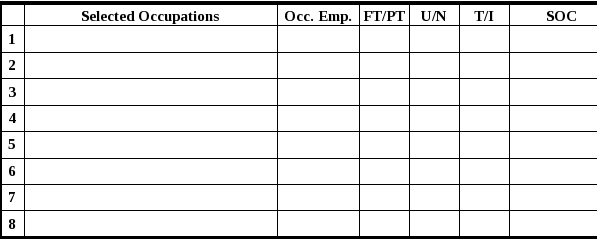ORS 4 PPD-4PA ORS Cognitive Elements Collection Form
Occupational Requirements Survey
ORS Form 4 PPD-4PA
ORS - Private Sector
OMB: 1220-0189
U.S. Department of Labor Bureau of Labor Statistics
|
Occupational Requirements Survey |
|
Private Industry |
The Bureau of Labor Statistics, its employees, agents, and partner statistical agencies, will use the information you provide for statistical purposes only and will hold the information in confidence to the full extent permitted by law. In accordance with the Confidential Information Protection and Statistical Efficiency Act of 2002 (Title 5 of Public Law 107-347) and other applicable Federal laws, your responses will not be disclosed in identifiable form without your informed consent. Per the Federal Cybersecurity Enhancement Act of 2015, Federal information systems are protected from malicious activities through cybersecurity screening of transmitted data.
|
This report is authorized by law, 31 United States Code §§ 1535/FAR 17.5 of the Economy Act. Your voluntary cooperation is needed to make the results of this survey comprehensive, accurate and timely.
|
O.M.B. #1220-0189 Expires #/##/####
|
We estimate that it will take an average of 66 minutes to complete this form, including time for reviewing instructions, searching existing data sources, gathering and maintaining the data needed, and completing and reviewing this information. If you have any comments regarding this estimate or any other aspect of this survey including suggestions for reducing this burden, please send them to the Bureau of Labor Statistics, Office of Compensation and Working Conditions (1220-0189), 2 Massachusetts Avenue N.E., Washington, D.C. 20212. You are not required to respond to the collection of information unless it displays a currently valid OMB control number. |
||


PRINT ADDITIONAL COPIES OF PAGES 3-16, AS NEEDED.
This page intentionally left blank.
Schedule/Quote: Work Schedule:
Additional notes:
COGNITIVE ELEMENTS - Supervision |
How frequently is work checked in this job by a supervisor or lead worker?
More than once per day
Once per day
Less often than once per day, but at least once per week
Less often than weekly
Enter the appropriate letter answer for each quote.


COGNITIVE ELEMENTS - Pace |
What most controls the work load for this job during the normal workday or work week?
Machinery, Equipment, or Software
(Company determined) numerical performance targets
People (such as customers, supervisor, etc.)
Self-paced by Worker
Other (specify)
Enter the appropriate letter answer for each quote.

How would you describe the pace of work for this job? Would you say that in a typical day or week…
The pace is consistent, and generally fast
The pace is consistent, and generally slow
The pace varies
Enter the appropriate letter answer for each quote.


COGNITIVE ELEMENTS - Interaction |
How often does this occupation require verbal, work-related interactions?
Constantly, every few minutes
Not constantly, but more than once per hour
Not every hour, but more than once per day
Once per day, or less often
Enter the appropriate letter answer for each quote.

The next question is about “people skills.” We define people skills as the ability to listen, communicate, and relate to others. In a job where basic people skills are required, workers often work alone, or usually are only expected to engage in simple, brief work-related communication and to treat other with respect. Does this job require basic or more than basic people skills?

COGNITIVE ELEMENTS – Problem Solving |
The next question is about “problem solving” tasks that the worker does in his/her job? Think of “problem solving” as what happens when workers are faced with a new or difficult situation which requires them to think for a while about what to do next. How often is the worker responsible for solving problems that take more than 5 minutes to think of a good solution?
More than once per day
Once per day
Not every day, but at least once per week
Not every week, but at least once per month
Less often than monthly, including never
Enter the appropriate letter answer for each quote.

COGNITIVE ELEMENTS – Public/Crowds/Telework |
Are workers in this job required to work with the general public?

Are workers in this job required to work around crowds in a way that restricts their movement?
(We define a crowd as a situation in which a lot of unfamiliar people are present considering the space available, movement is restricted, and a certain level of disorganization is present.)

Are workers in this job permitted to work from home or telework?

Exertion – Sit/Stand/Walk
|
|
|
How many hours a day does an employee in this job usually …?
(Enter the appropriate number of hours for each quote.)

Does this job offer the typical employee the choice to alternate between sitting and standing at will throughout the day?

Exertion – Lifting/Carrying
|
|
|
Enter the appropriate number of pounds for each quote. (Breaks at 1/10/25/50/75/100)

What is the most weight an employee would generally lift or carry for more than 2/3 of the time?
(More than 5 ½ hours of an 8-hour workday)

What is the most weight an employee would generally lift or carry from 1/3 up to 2/3 of the time?
(From 2 ½ hours to 5 ½ hours of an 8-hour workday)

What is the most weight an employee would generally lift or carry up to 1/3 of the time?
(From 10 minutes up to 2 ½ hours of an 8-hour workday)

What is the most weight an employee would generally lift or carry up to 2% of the time?
(Up
to 10 minutes of an 8-hour workday)

Exertion – Pushing/Pulling
|
|
|
Pushing/Pulling is present when a worker uses at least ten pounds of force, or uses any amount of force for 2/3 or more of the workday.
How much of their day do employees in this job generally push or pull an object with their hands/arms?

1A. Does the pushing/pulling require one hand/arm or both?

How much of their day do employees in this job generally push or pull an object with their feet/legs?

2A. Does the pushing/pulling require one foot/leg or both?

Reaching/Manipulation
|
|
How much of their day do employees in this job generally reach overhead?
(Reaching overhead is present when the hand goes higher than the head AND a) elbow is bent and the angle at the shoulder is 90 degrees or more, or b) elbow is extended and the angle at the shoulder is 120 degrees or more.)

1A. Does the overhead reaching require one hand/arm or both?

How much of their day do employees in this job generally reach at or below shoulder level?
(At/Below
the Shoulder Reaching is present when there is Reaching, but it does
not meet the threshold for Overhead Reaching.)

2A. Does the reaching at or below shoulder level require one hand/arm or both?

How much of their day do employees in this job generally hold, grasp, turn, or otherwise work with their hand(s) (gross manipulation)?
(Note: Do not include time spent keyboarding.)

3A. Does this require one hand or both?

How much of their day do employees in this job generally pick, pinch, or work primarily with the fingers (fine manipulation)?
(Note: Do not include time spent with traditional keyboarding.)

4A. Does this require one hand or both?

How much of their day do employees in this job generally operate foot/leg controls (use of one or both feet or legs to move controls on machinery or equipment)?

5A. Does this require one foot/leg or both?

How much of their day do employees in this job generally keyboard (enter text or data into a computer or other machine) using a traditional keyboard?

Postural |
|
Do any critical tasks require lowering to, or positioning over, something at or below knee level, including on or near the ground (stooping, kneeling, crouching, crawling)?

1A. If yes, select how the following types of low postures are used:
Yes, required (employees must use this posture because of nature of task(s), physical setting of work environment, or company specifics)
Yes, workers choice (employees not required to use posture, but typically do)
No (posture not used)
Unknown
Enter the appropriate letter answer for each quote.

Postural – Climbing |
|
1A. How much of their day to employees in this job climb ramps or stairs?
(Note: Only collect duration if climbing is work related.)

How much of their day do employees in this job generally climb ladders, ropes, or scaffolding?

Auditory |
|
How much of their day do employees in this job spend on work related speaking (express or exchange ideas by spoken word)?

Does this job require employees to hear and understand in person speaking?

Does this job require employees to hear and understand communication over the telephone?

Does this job require employees to hear and understand other remote speaking?

Does this job require employees to hear and understand other sounds?

Vision |
|
Does this job require employees to see details of objects 20 inches or less away clearly (including the use of computers) (near visual acuity)?

Does this job require employees to see details of objects greater than 20 feet away clearly (far visual acuity)?

Does this job require employees to have a broad field of vision (exclude general awareness) (peripheral vision)?

Environmental Conditions |
|
How much of their day do employees in this job generally work outdoors?

How much of their day do employees in this job generally work in non-weather related extreme heat (90° or above in a dry environment, 85° or above in a humid environment)?

How much of their day do employees in this job generally work in non-weather related extreme cold (40° for more than 2/3 of the day, 32° if less than 2/3 of the day)?

Excluding weather, how much of their day do employees in this job generally come in contact with water or other liquids?

How much of their day do employees in this job generally work in non-weather related humidity?

How much of their day do employees in this job generally encounter heavy vibration (exposure to a shaking object or surface that causes a strain on the body or extremities)?

How much of their day do employees in this job generally come in contact with hazardous contaminants (substances that may have a negative impact upon respiration, eyes, skin, or other living tissue via inhalation, ingestion, or contact)?
 *Document
the use of Personal Protective Equipment (PPE) if the element is
present.
*Document
the use of Personal Protective Equipment (PPE) if the element is
present.
How much of their day do employees in this job generally work in conditions where bodily injury from moving, mechanical parts of equipment, tools, or machinery is possible?
 *
Document the use of Personal Protective Equipment (PPE) if the
element is present.
*
Document the use of Personal Protective Equipment (PPE) if the
element is present.
How much of their day do employees in this job generally work in high, exposed places?
 *
Document the use of Personal Protective Equipment (PPE) if the
element is present.
*
Document the use of Personal Protective Equipment (PPE) if the
element is present.
 *
Document the use of Personal Protective Equipment (PPE) if the
element is present.
*
Document the use of Personal Protective Equipment (PPE) if the
element is present.
ORS Form 4 PPD-4PA
| File Type | application/vnd.openxmlformats-officedocument.wordprocessingml.document |
| Author | keene_t |
| File Modified | 0000-00-00 |
| File Created | 2021-01-14 |
© 2025 OMB.report | Privacy Policy



